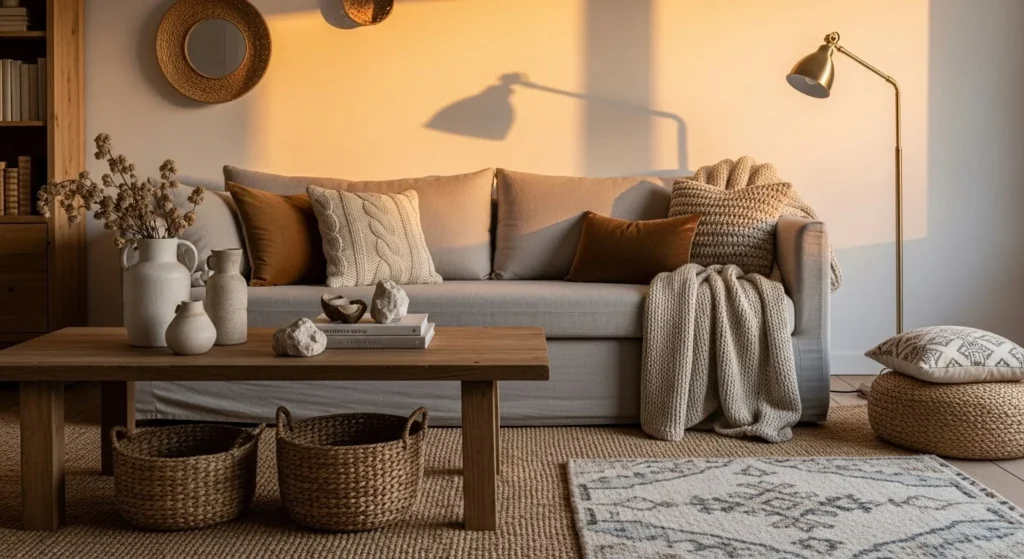8 Textured Living Room Design Ideas to Add Depth and Warmth
A textured living room feels inviting before you even sit down. Texture gives flat surfaces dimension, softens hard edges, and makes a space look thoughtfully layered—not just decorated. Below are eight detailed, practical ways to build depth and warmth with texture, plus pro tips, budget swaps, and maintenance notes so your room looks good and lives well. Here are 8 Textured Living Room Design Ideas to Add Depth and Warmth.
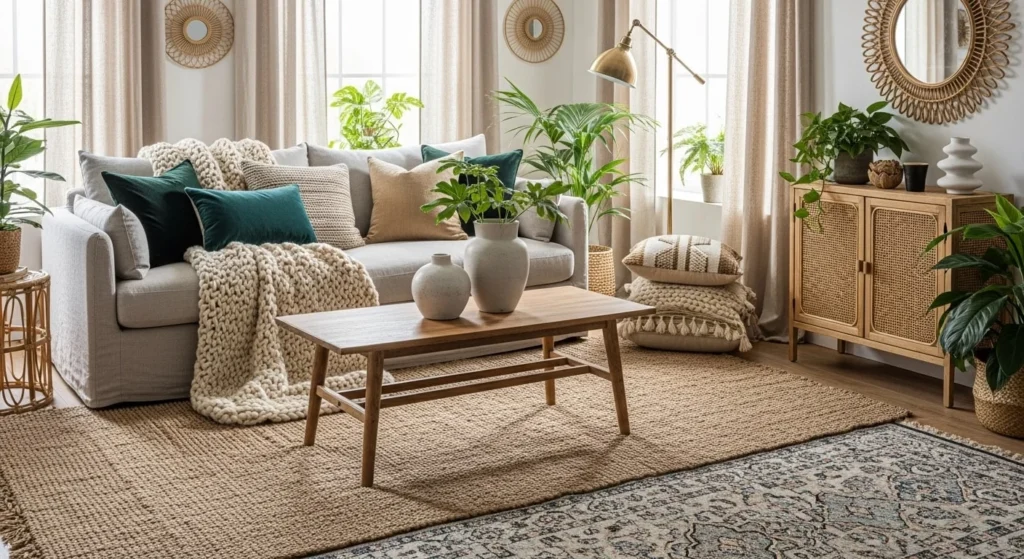
1) Layer Textiles Like a Stylist (Sofas, Throws, Pillows, Curtains)
Why it works: Soft materials add immediate tactile comfort and visual rhythm through weave, nap, and drape.
How to do it
- Start with a base fabric on the largest piece (sofa/sectional). Linen, heavy cotton, performance bouclé, or a tight chenille create a subtle, nubby foundation.
- Mix three pillow textures: e.g., linen (matte), velvet (sheen), and a chunky knit (coarse). Keep inserts consistent (down/alternative) so they sit similarly.
- Add a throw with visible weave—waffle, cable knit, or handloomed fringe—to break up smooth seat cushions.
- Use lined, textural curtains (linen-linen blends, raw silk dupioni, or cotton slub). Puddle lightly or kiss the floor to emphasize the fabric’s body.
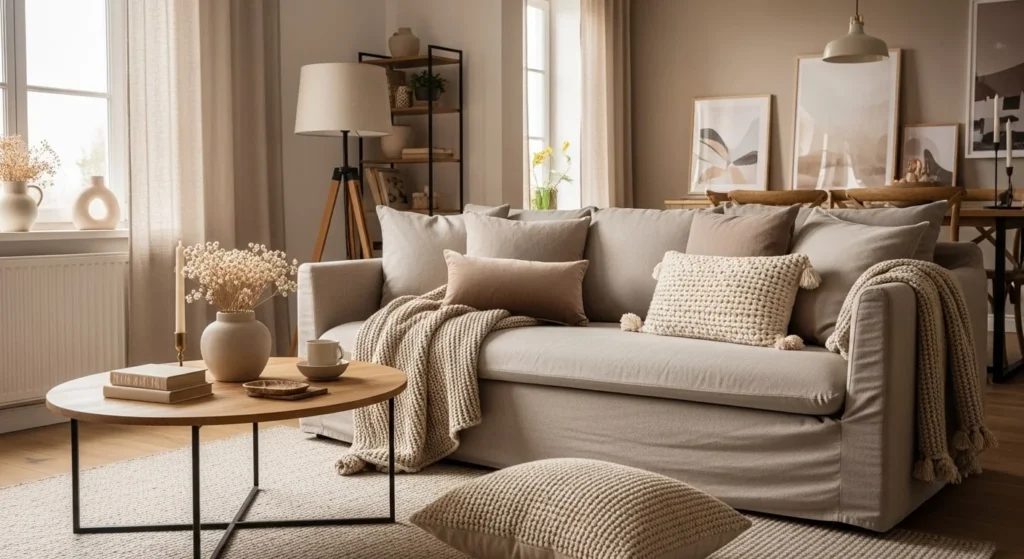
Palette tip: When mixing textures, keep the color story tight (2–3 hues + 1 accent) so the room reads cohesive, not busy.
Budget swap: IKEA, H&M Home, and Etsy shops for artisan pillow covers. Upgrade inserts to 90/10 down for better loft.
Maintenance: Rotate textiles seasonally; machine-wash cotton/linen covers, dry-clean velvet and wool.
2) Create Architectural Texture on Walls (Paneling, Limewash, Plaster)
Why it works: Walls occupy the largest visual field; giving them texture changes the room’s mood immediately.
Options
- Applied millwork: beadboard, board-and-batten, picture-frame molding. Paint in eggshell or satin to catch light.
- Troweled finishes: limewash or Venetian plaster for organic movement and a velvety matte-to-sheen shift.
- Textural wallpapers: grasscloth, sisal, silk, or embossed paintable papers when you want pattern + texture.
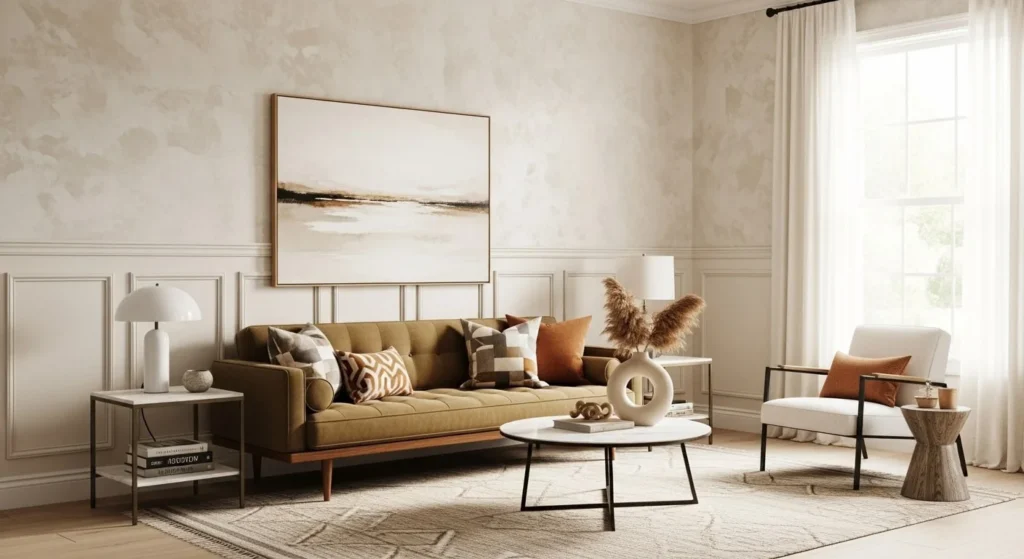
How to do it (stepwise)
- Choose one feature wall or wrap the entire room if ceilings are 9’+.
- Sample two sheens and two undertones; texture reads differently in warm vs. cool light.
- Terminate paneling with a chair rail or picture ledge to add another layer.
Budget swap: Use paintable textured wallpaper to mimic plaster; finish with a mineral or limewash topcoat.
Maintenance: Grasscloth stains—keep it away from splash zones; limewash is touch-up friendly but can mark with abrasion.
3) Mix Natural Materials (Wood, Stone, Rattan, Leather)
Why it works: Nature-made textures have irregular grain/veining that keeps the eye engaged.
Material recipe
- One prominent wood tone (coffee table or media console) +
- One woven element (rattan chair, cane cabinet doors, seagrass basket) +
- One stone (travertine side table, marble tray, soapstone mantle) +
- One hide or leather (ottoman, accent chair) for temperature contrast.
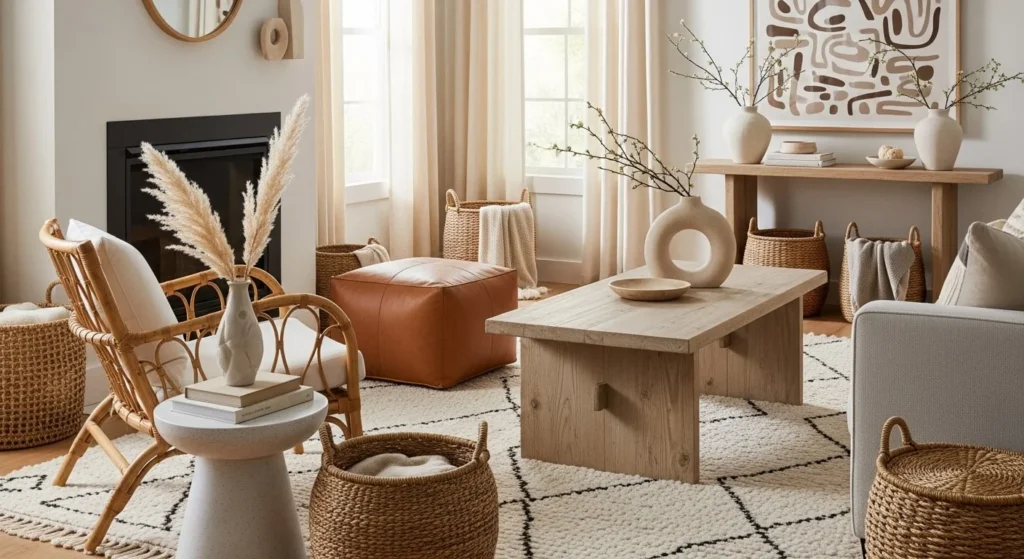
Pro tip: Vary finishes—pair closed-grain walnut with open-weave rattan; polished stone with matte oiled oak.
Budget swap: Travertine-look porcelain side tables or stone trays instead of solid slabs.
Maintenance: Condition leather 2–4×/year; use coasters on stone to prevent etching.
4) Double Up on Rugs (Pile + Flatweave)
Why it works: Underfoot layers add visual depth and dampen sound, making the room feel calmer.
How to do it
- Anchor rug: a big, durable flatweave (jute, sisal, or wool kilim) sized to front-legs-on for all seating.
- Top rug: smaller, softer pile (Moroccan/Beni-style, hand-tufted wool, or low-pile vintage).
- Align edges or offset slightly to look intentional.

Sizing guide: Aim for the top rug to cover 60–70% of the base rug within the seating zone.
Budget swap: Use a thick felt rug pad under a thinner top rug to fake plushness.
Maintenance: Vacuum base jute on low suction; rotate every 6 months to even wear.
5) Use Lighting to Cast Texture (Shades, Shadows, Sheen)
Why it works: Light reveals texture. The right fixtures create shadow play that makes surfaces look richer.
Layered plan
- Ambient: a linen drum pendant or textured paper shade diffuses light softly.
- Task: ribbed-glass or pleated-shade table lamps for glow + pattern.
- Accent: picture lights or wall washers grazing a paneled or plastered wall to emphasize relief.
- Materiality: ceramic, terracotta, hammered metal, or woven reed shades add tactile presence even when off.
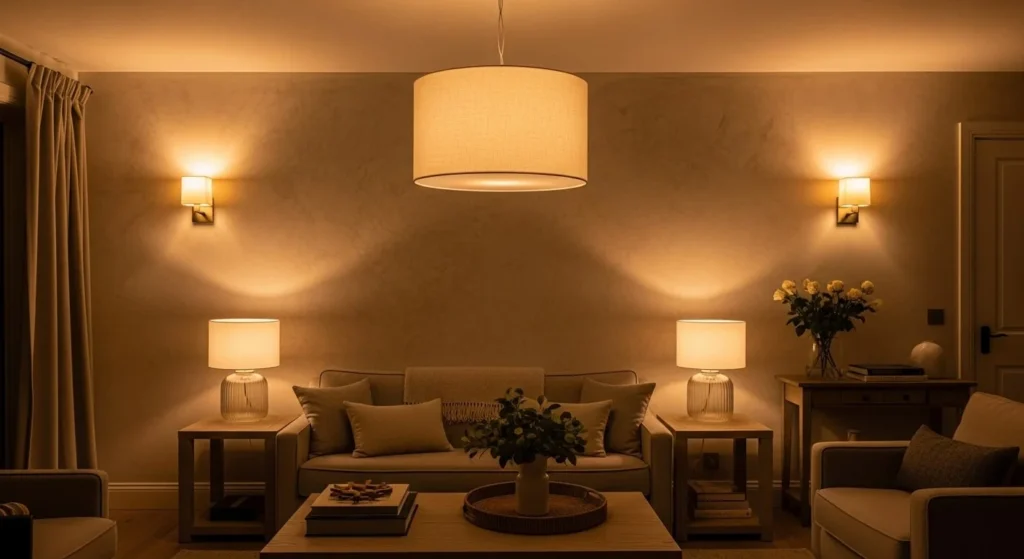
Color temperature: 2700–3000K for warmth; use dimmers on all circuits.
Maintenance: Dust fabric shades with a lint roller; avoid harsh cleaners on metal patinas.
6) Combine Metal & Wood Finishes (But Keep a System)
Why it works: Mixed finishes = layered narrative; reflective + matte interplay adds complexity.
Simple rule set
- Pick one dominant metal (e.g., aged brass) and one supporting metal (blackened steel).
- Keep wood species to two (e.g., white oak + walnut).
- Repeat each at least three times around the room (lamp, frame, hardware) so nothing looks accidental.
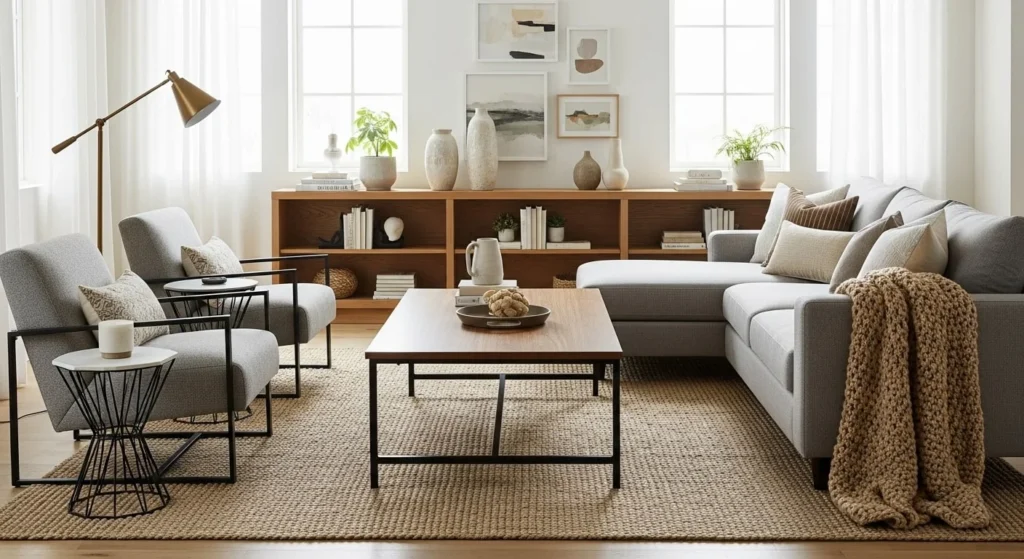
Where to add: Picture frames, curtain hardware, lamp bodies, accent tables, media unit pulls.
Budget swap: Spray-paint inexpensive hardware with high-heat black or rub ’n buff for antique brass look.
Maintenance: Let unlacquered brass age; spot-polish only if needed.
7) Sculpt With Art & Objects (Relief, Ceramics, Textiles)
Why it works: Raised and irregular surfaces give your eye landing spots and break planar monotony.
What to use
- Textile art: framed vintage kilim fragment, mud cloth, or handwoven piece.
- Relief works: plaster casts, bas-relief panels, carved wood plaques.
- Ceramics: matte stoneware vases, terracotta amphorae, hand-thrown bowls.
- Books: linen or canvas spines add quiet pattern.
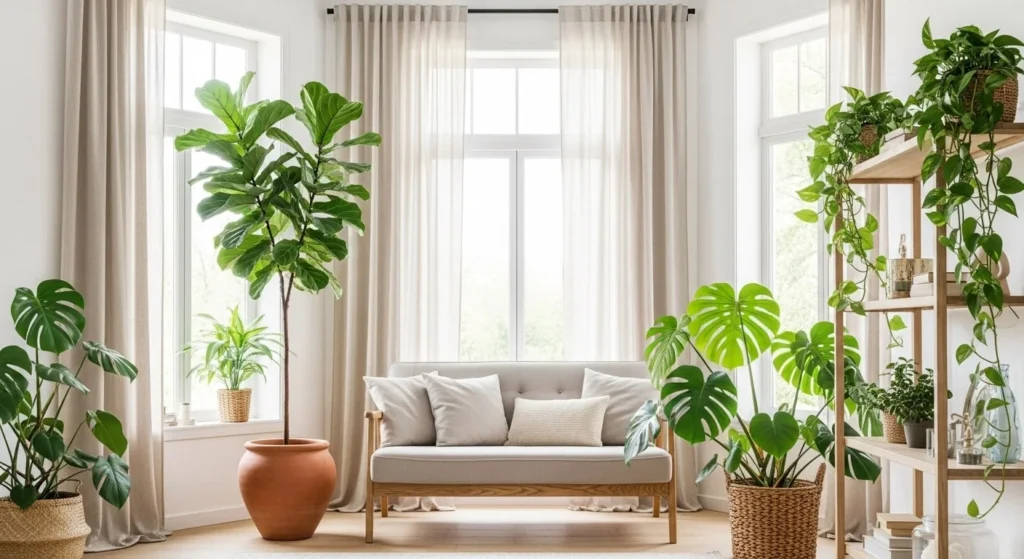
Arrangement tip: Build high/low groupings (e.g., tall vase + squat bowl + textured book stack) in odd numbers (3/5).
Budget swap: DIY plaster-on-canvas art; thrift ceramic vessels and strip glossy glaze with matte topcoat spray.
Maintenance: Keep textiles out of direct sun; dust ceramics with a soft brush.
8) Bring in Living Texture (Plants & Natural Elements)
Why it works: Foliage adds organic form, micro-texture, and color variation that shifts with light.
Plant palette
- Large form: fiddle-leaf fig, olive tree, rubber plant—choose one sculptural anchor.
- Medium filler: fern, monstera, or dracaena for feathery vs. bold leaf textures.
- Small accents: trailing pothos on shelves; moss bowl on coffee table.
- Natural add-ons: branches in an oversized vase; mixed pinecones in a stone bowl.
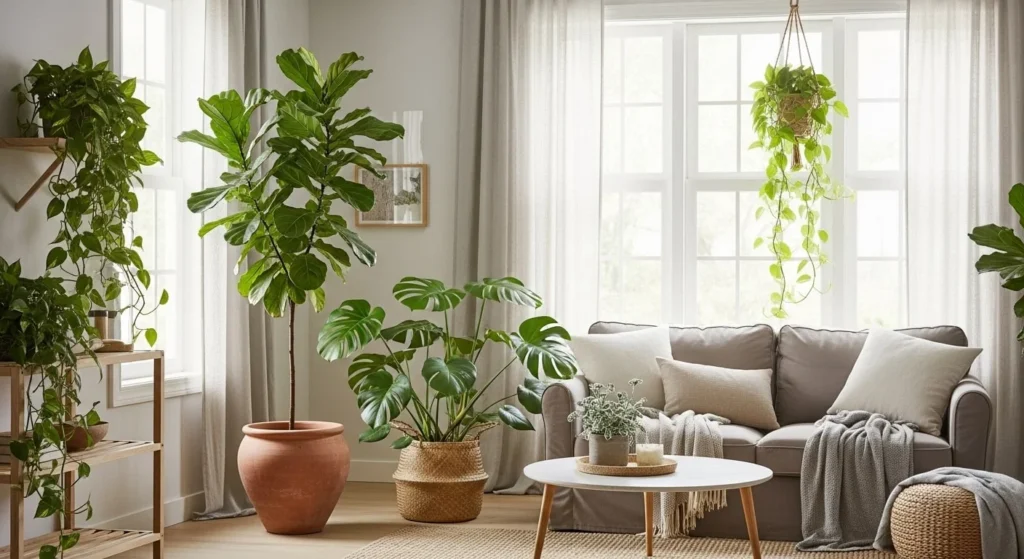
Vessels: Use rough clay, carved wood, or basket sleeves to double the textural effect.
Maintenance: Group plants by light/water needs; rotate pots for even growth; use felt pads under heavy planters.
Pulling It Together: Three Ready-Made Texture “Recipes”
A) Warm Neutral Haven
- Linen slipcovered sofa + velvet pillows + chunky knit throw
- Limewash walls in warm greige
- Jute base rug + wool Beni topper
- Aged brass floor lamp + ceramic table lamp
- Oak coffee table, travertine side table, terracotta planters
B) Moody Modern Mix
- Bouclé or chenille sectional in deep taupe
- Venetian plaster feature wall, satin black trim
- Flatweave wool rug + low-pile vintage Turkish topper
- Blackened steel sconces grazing wall texture
- Walnut media console, leather sling chair, stoneware vases
C) Coastal Organic Calm
- Cotton-linen sofa, striped linen pillows
- Beadboard wainscot, matte off-white paint
- Seagrass rug + soft blue hand-knotted topper
- Woven rattan pendants + ribbed glass table lamps
- White oak sideboard, coral branches (faux), linen-draped windows
Common Mistakes (and Quick Fixes)
- Too many colors with too many textures: Limit to 3–4 core colors; let texture do the talking.
- Everything glossy or everything matte: Mix sheen levels (matte wall + satin trim + velvet pillow).
- Tiny rug: Size up; layers only work when the base rug anchors all seating.
- Ignoring vertical planes: Balance seat-level texture with wall/curtain/lighting textures.
- One-off finishes: Repeat each material at least thrice.
Small Spaces & Rental-Friendly Moves
- Peel-and-stick options: grasscloth-look wallpaper, beadboard panels, or foam molding.
- Textile dominance: heavier curtains, layered pillows/throws, and a topper rug instantly add depth without construction.
- Portable lighting: plug-in sconces with fabric cords; textured shades for character.
- Nesting side tables: introduce multiple finishes without crowding.
Care & Longevity
- Vacuum rugs and upholstery weekly on low suction; use a fabric shaver on pilling.
- Spot-test cleaners on limewash/plaster; use mineral-based touch-up paints.
- Condition woods and leather per manufacturer guidance; avoid direct heat and UV where possible.
- Rotate rugs, pillows, and plants every few months to even wear and sun exposure.
Quick Shopping Checklist
- 1–2 large textile anchors (sofa fabric, lined curtains)
- 3–5 mixed pillows (linen, velvet, knit) + chunky throw
- Base rug (jute/sisal/flatweave) + top rug (wool/vintage) + rug pad
- Wall texture (paneling kit, limewash, or textural wallpaper)
- Mixed materials: one stone, one leather, one woven piece
- Lighting trio: ambient pendant, task lamp, accent/wash light
- Sculptural object set: ceramic vase, relief art, textile piece
- Greenery: 1 large, 1–2 medium, 1–3 small plants + textured vessels
FAQ of Textured Living Room Design Ideas
Final Thought of Textured Living Room Design Ideas
Texture is the quiet luxury of living rooms: it doesn’t shout, it layers. Start with one big move (wall finish or rug layering), echo it in two to three places, and let your materials do the warming up for you.
